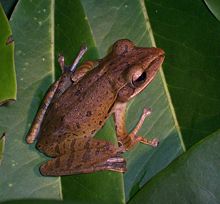Golden treefrog
| Common tree frog | |
|---|---|
 |
|
| Common tree frog (female) | |
 |
|
| Adult at Darmaga (Bogor Regency, West Java, Indonesia) | |
| Scientific classification | |
| Kingdom: | Animalia |
| Phylum: | Chordata |
| Class: | Amphibia |
| Order: | Anura |
| Family: | Rhacophoridae |
| Genus: | Polypedates |
| Species: | P. leucomystax |
| Binomial name | |
|
Polypedates leucomystax (Gravenhorst, 1829) |
|
| Synonyms | |
|
|
Polypedates leucomystax is a species in the shrub frog family Rhacophoridae. It is known under numerous common names, including common tree frog, four-lined tree frog, golden tree frog or striped tree frog. Many past authors have united it with the common Indian tree frog in P. maculatus (or Rhacophorus maculatus, as was common in older times), but today they are generally considered distinct species. In its native range, it is also called "white-lipped tree frog", but this name is otherwise applied to a species of true tree frogs (family Hylidae).
Polypedates leucomystax is not considered a threatened species by the IUCN. It is in fact a species complex containing various cryptic species within it.
Previously, P. leucomystex was thought to distribute below the Red River of Vietnam and in western Yunnan, while P. megacephalus can be found above the Red River and in Northeast India. However, recent genetic studies revealed that the natural barriers between these species are the Isthmus of Kra and the Tenasserim Range, where P. leucomystax can be found below the isthmus and west of the range.
The Polypedates leucomystax complex began diverging during the Pliocene, and spread quickly after the due to human activity. The range of P. leucomystax has recently expanded in the Philippines and Indonesia due to the widespread conversion of forests into agricultural-use land. It is also frequently found in trans-island agricultural shipments. Lineages on the Indochina mainland are more diverse.
...
Wikipedia

